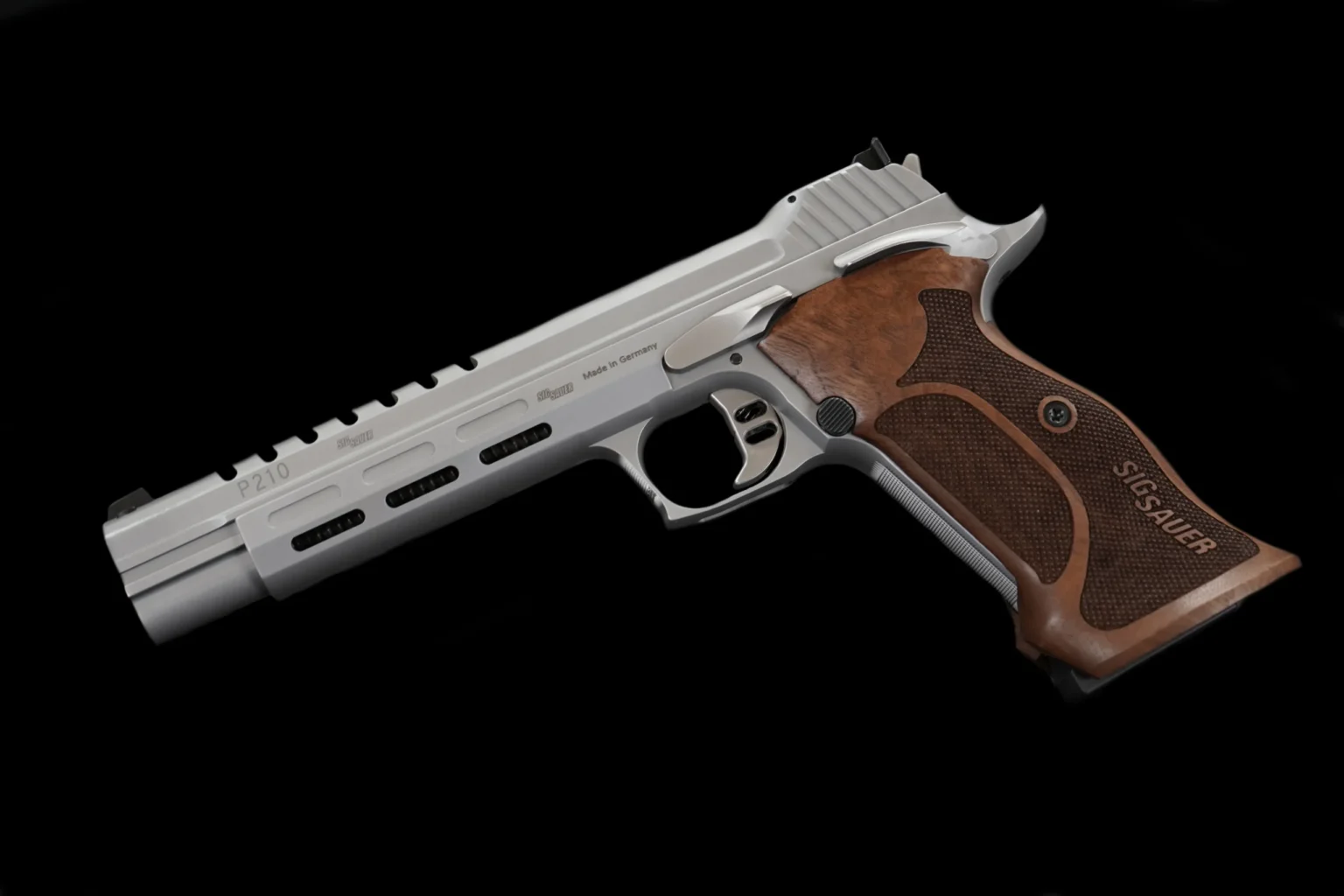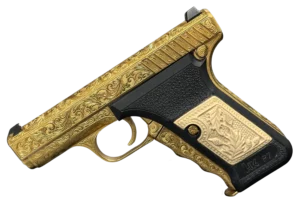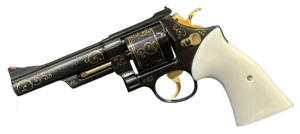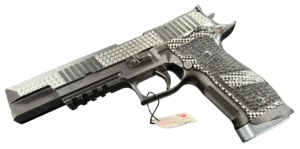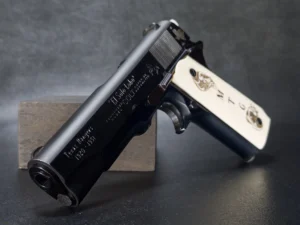Key Takeaways:
- The Mastershop wasn’t just a custom shop — it was a full-on celebration of what happens when craftsmanship, technology, and personal expression collide: These weren’t your average tune-ups. Whether you wanted gold inlays, competition triggers, or just a pistol that felt like yours, the SIG Sauer Mastershop made that happen — with soul.
- Each tier (Prestige, Individual, Sport) spoke a different language — luxury, personalization, or pure performance — but all of them shared the same obsessive attention to detail: No shortcuts. No fluff. Just guns that looked incredible, shot even better, and carried a story with every detail.
- Even though it’s gone, the Mastershop’s legacy still echoes in the world of custom firearms — in the way people talk about “that one SIG” they’ll never sell: It raised the bar, set the tone, and reminded everyone that sometimes, a gun can be more than just a tool. It can be art.
Let’s start with the obvious: most guns do their job just fine right out of the box. They go bang when they’re supposed to, hit what you’re aiming at (most of the time), and look decent sitting in a safe.
But what if that’s not enough?
What if you want something that feels like it was built just for you, not just a machine, but something with soul? That’s where the SIG Sauer Mastershop came in.
This wasn’t your average gunsmithing corner. The Mastershop was where function met obsession, where German engineering collided with artistry. It was SIG Sauer’s boutique division — the secret handshake behind some of the most jaw-dropping custom firearms ever produced under the SIG name.
And now? It’s gone. At least in the form we once knew.
So what made the Mastershop so special? Why are collectors still whispering about it? Let’s dig in.
Where Passion and Precision Met: The Heart of the Mastershop
Calling it “just a service” feels wrong — almost insulting. The SIG Sauer Mastershop was more like a high-end custom garage for your favorite firearm. Think West Coast Customs, but instead of tricking out cars, they were perfecting pistols. Every gun that went in came out… better. Sharper. More personal.
And it wasn’t a one-size-fits-all operation. The Mastershop had layers — literal tiers — depending on what kind of dream you were chasing:
- Prestige – for when you wanted your pistol to belong in a velvet-lined display case.
- Individual – the middle path, full of freedom and personality.
- Sport – no-frills performance for people chasing split-second wins.
Each tier had its own philosophy, its own vibe. But they all shared one thing: precision so exact, it bordered on obsessive.
Customization, but Make It Art
If you’ve ever held a gun that’s been through the Mastershop, you know — it’s different. The balance is just right. The trigger breaks like glass. The finish isn’t just a color; it’s a mood.
Here’s the kind of stuff the Mastershop would do:
- Hand-fit triggers and tuned actions
- Custom grips molded to your hand
- Engraving work that looked like it belonged in a museum
- Finishes that went way beyond “black” and “stainless”
- Sights, barrels, slide cuts, you name it
None of it was rushed. Everything was deliberate.
And the coolest part? These weren’t cookie-cutter packages. You worked with real people — gunsmiths who cared — to figure out what you wanted. And then they made it happen.
Prestige Tier: Firearms That Dress Better Than You Do
Let’s be honest — this was the “treat yourself” tier.
Prestige builds weren’t just about performance (though they had that, too). They were about statement. These guns came dressed to the nines: gold inlays, hand-carved grips, Damascus steel slides, fine scrollwork that made you look twice — and then again.
It was like owning a Swiss watch that also shot 9mm.
You didn’t get a Prestige build to throw in a glove box. You got it because it felt like someone sculpted your firearm out of sheer love and time.
Individual Tier: One-Offs with Personality
This was where things got interesting.
The Individual tier was all about creating something that fit you. Your hand size, your shooting style, your weird-but-you-love-it taste in colors. This is where custom engraving came in. Want your initials? A family crest? Some wild Celtic knotwork or modern geometric patterns? Done.
These guns weren’t just aesthetically unique — they felt different. Recut grip angles, extended controls, refined trigger travel — it was all in play.
It was the most “you” a SIG could get without learning your name and calling you at dinner.
Sport Tier: Performance Tuned, Track-Ready
If the other tiers were luxury sedans, Sport was the stripped-down race car.
These builds were all business: match triggers, flared magwells, optimized barrel fit, competition sights, the works. Everything that would shave milliseconds off your time or make that follow-up shot land just a little faster.
These guns had a different energy. They weren’t meant to be admired in glass cases — they were meant to be run hard and often. And somehow, they still looked damn good doing it.
Behind the Magic: Techniques, Tools, and That Human Touch
Now, let’s not pretend this was some artisanal workshop where every part was forged by moonlight. The Mastershop embraced tech. Big time.
- Laser engraving meant details so fine they looked painted on.
- CNC machining brought tolerances down to the hair-splitting.
- Advanced coatings kept finishes beautiful and tough.
But machines weren’t the whole story.
Every component was still hand-fit. Every trigger still tested by a human finger. Every slide cycle, every sight alignment, still checked and double-checked by someone who genuinely cared about the end result.
That balance — between modern technology and old-school craftsmanship — is what made the Mastershop feel alive. It wasn’t soulless. Far from it.
Custom Options Galore — Because Why Not?
Let’s walk through some of the bits and pieces you could mess with in the Mastershop:
Finishes
Yeah, you could pick matte black and call it a day. Or you could go bold: brushed stainless, Cerakote in any color under the sun, PVD gold that glinted in the light, blued steel so deep it looked like night.
Functionally, finishes helped with corrosion and wear resistance. But also? They just looked awesome.
Grips & Ergonomics
Don’t underestimate what a good grip can do. The Mastershop offered custom wood, rubber, polymer — even sculpted designs made just for your hands. Whether you had big paws or tiny fingers, they could make it work.
Triggers & Action Work
You know that awful, gritty creep some factory triggers have? Yeah, none of that here. Mastershop triggers were crisp, consistent, and just… right. Like clicking a mechanical keyboard after years on a mushy laptop.
Sights
You could go traditional — three-dot irons, fiber optics — or dive into competition-ready red dots and adjustable rears. Whatever helped you see faster, shoot straighter, and win harder.
The Legacy Factor: Why the Mastershop Still Matters
Let’s zoom out for a second.
SIG Sauer’s reputation didn’t just come from issuing guns to elite military units or cranking out reliable duty pistols. The Mastershop played a huge part in building that prestige.
These weren’t mass-market builds. They were SIG’s way of saying, “Here’s what we’re really capable of.” They were flexes — elegant, precise flexes — that said SIG could do artistry just as well as utility.
And for collectors? A Mastershop SIG is like finding a first-edition vinyl pressed in gold. It’s rare, it’s beautiful, and its value usually goes nowhere but up.
Real People, Real Guns: The Human Side of It All
You know what really made the Mastershop special? The people who bought from it. Their stories.
One guy might’ve ordered a build to celebrate retiring after 30 years in law enforcement. Another might’ve commissioned a pistol as a wedding gift. Some folks just wanted a competition-ready machine they could trust with their life.
They all had different reasons, but one thing in common: when they held that Mastershop firearm, it meant something.
Reviews and testimonials still float around forums and collector circles:
“It’s almost too beautiful to shoot — but it shoots like a dream.”
“It fits my hand like a glove. I’ve never fired anything smoother.”
“I didn’t buy it for resale value, but damn, I could probably pay rent with it now.”
And they weren’t exaggerating. These guns often appreciate over time. That’s what happens when you mix rarity, craftsmanship, and demand.
How to Take Care of One (If You’re Lucky Enough to Have One)
If you’ve got a Mastershop SIG, you’re holding a piece of firearms history. So please, for the love of all that’s good, take care of it.
- Clean it regularly, even if it’s a safe queen.
- Lube it like you mean it (follow SIG’s guide, not some random dude on YouTube).
- Store it in a dry place — seriously, humidity is the enemy of steel and wood.
You’re not just preserving function. You’re preserving craftsmanship.
Other Custom Shops vs. the Mastershop
So, how did the Mastershop compare to other big-name custom builders?
Look, plenty of amazing gunsmiths are out there — Nighthawk Custom, Wilson Combat, Langdon Tactical. They each have their thing. Their edge.
But the Mastershop had the advantage of being inside the SIG machine. That meant access to original parts, design specs, engineering data — the whole vault. Plus, it was SIG building the SIG. That counts for something.
It’s not about better or worse — it’s about what kind of story you want your firearm to tell. The Mastershop just happened to write some of the best ones.
Looking Ahead: Is There Life After the Mastershop?
Here’s the weird part: the SIG Sauer Mastershop, in its original form, is no longer running.
Why? Corporate strategy? Market focus? Who knows. Maybe it was just time.
But its influence is everywhere. SIG fans still talk about Mastershop builds in hushed, reverent tones. Other companies have started offering more factory customization options. Custom guns are hotter than ever — and you can thank the Mastershop for setting that bar.
Will it ever return? Maybe in some new form. One can hope.
But even if it doesn’t, the legacy’s intact. The blueprint is out there. And the passion it sparked? Still very much alive.
Final Thoughts: More Than Just a Fancy Gun
So here’s the thing — the SIG Sauer Mastershop wasn’t just about making firearms prettier, or faster, or more exclusive. It was about care. It was about what happens when people who truly understand guns — and love them — get the time and tools to build something special.
Whether you own a Mastershop build, dream of one, or just appreciate the idea of craftsmanship in a world of mass production, there’s something here for all of us.
Because at the end of the day, what the Mastershop gave us wasn’t just better guns.
It was proof that guns could be more.
Frequently Asked Questions
Think of it as SIG Sauer’s custom dream lab. It was where you went if you wanted your firearm to be more than just a stock model. More accuracy, better looks, tailored feel — the works. They did everything from competition tuning to museum-worthy engraving.
Sadly, no, not in the way it used to be. SIG shifted away from the original Mastershop concept, and it’s no longer offering those same in-house custom services. That said, Mastershop builds are still out there, and collectors highly seek after them.
Everything. The attention to detail, the hand-fitting, the custom finishes, the tuned triggers — these weren’t just tweaks. They were full-on transformations. Each piece felt like a passion project from someone who cared.
Both. Some folks shot them competitively. Others kept them in pristine condition. A few probably just took them out of the safe to stare at them — and honestly, we get it.
Prices varied significantly depending on the tier and options, but they weren’t inexpensive. Prestige builds, especially, could run into the several-thousand-dollar range. You were paying for craftsmanship, rarity, and the SIG Sauer name — and in most cases, it was worth it.


